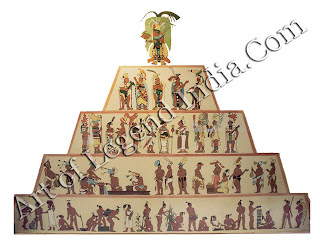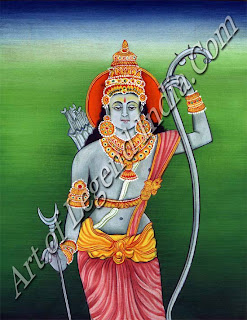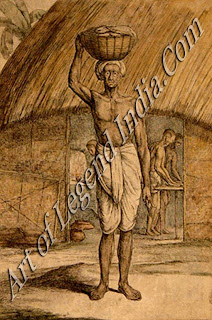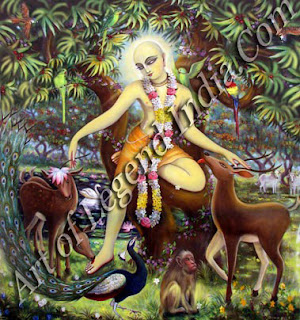The aim of the Hindu being to break this chain of birth and rebirth that binds him to the earth, the first step to be taken on this path is for each one to perform well his own dharma or righteous duties. Hinduism is unique because it differentiates between the duties of man and man, as also between the duties to be followed at various stages of one's life. Lord Rama's dharma as an exile for 14 years was different to his later dharma as a ruler. The teacher, the nurse, the priest, a mother or father each has to follow his or her own dharma. Duties, whatever they are, have to be performed with excellence and moral purity as the goal.
The concept of Dharma is fundamental to Hinduism, as it is believed that it is only through the pursuit of Dharma that there is social harmony and peace in the world. The pursuit of Adharma (a path that rejects righteousness) leads to conflicts, discord and imbalance.
The saying, Dharanat Dharmah' means Dharma sustains the world and it is that which holds the world together. It is duty performed with righteousness, with discipline and moral and spiritual excellence. Varnashrama Dharma is fundamental to Hindu belief and includes the duties of the various occupations, orders and classes (Varna) and the duties in the four stages (ashramas) of one's life. It enjoins that each person's dharma or duty depends on his occupation, position, moral and spiritual development, age and marital status.
The Caste System
 Although the caste system has now been legally abolished, it is interesting to know its origin. The original meaning of the word `varna' was order or class of people. When the Indo-Aryans invaded the country, they came across the local inhabitants whom they called Dasas or Dasyus. Instead of destroying them after conquest, as has happened in other civilizations, they absorbed them by giving them a lower but definite place in their society.
Although the caste system has now been legally abolished, it is interesting to know its origin. The original meaning of the word `varna' was order or class of people. When the Indo-Aryans invaded the country, they came across the local inhabitants whom they called Dasas or Dasyus. Instead of destroying them after conquest, as has happened in other civilizations, they absorbed them by giving them a lower but definite place in their society. In time this system came to be four-tiered, with four classes, the Brahmanas or Brahmins (not to be confused with the Brahman) who were the teachers and priests, the Kshatriyas or warriors and rulers, the Vaishyas, those who followed commercial occupations, and the Sudras who performed manual labour and were also farmers and agriculturists. The word 'varna' therefore implied the social order and not caste, as even Manu has given the difference between Varna (class or order) and jati (sect of birth or caste). A man's Varna depended as much on his mental and physical equipment as on heritage. Therefore it was a fluid state. A Brahmin for example, was one who evolved with the guna or qualities and performed the karma, or action, enjoined on a Brahmin. (It was only later that the word `varna' came to mean colour.)
The jails (or sects) in time became more important than the four main classes. These were mainly occupational (like the goldsmith jail, the weaver jati, the carpenter jail etc.) and served the purpose of guilds which protected the interests of their members, trained the young and saw to it that no outsider entered the fold. In time these jails or sects grouped themselves under the main classes which is why we speak today of four castes. However, it is not the caste of a man but his sect that is important to this day. Even today these sects often do not permit fluidity of movement, even where the old occupations have broken down and new ones have come in.
The untouchables or outcastes were originally those who had broken certain caste rules. For example, the Nayadis, who were considered outcastes of the lowest order, were originally Brahmins who were excommunicated for some reason. Also later the Hindus, who were originally meat-eaters, slowly changed their eating habits to vegetarianism, especially the Brahmins and Vaishyas who were influenced by early Buddhism and Jainism. With this change, those who ate beef or the meat of certain proscribed animals came to be considered outcastes or untouchables, as, by this time, the cow had come to be regarded akin to a mother, the people, being largely rural, having to depend on the cow's products for sustenance. (This is why the cow is given the reverence due to a mother in Hindu society to this day.)
 However there is no religious sanction whatsoever in Hinduism to the concept of untouchability although later additions on the subject were inserted into the earlier scriptures to justify its existence. It was a purely social practice introduced by the upper castes to provide themselves with menial labour to perform certain tasks repulsive to themselves such as those of cemetery keepers, scavengers and cleaners. Hindu society has much to answer for this inhuman treatment of a whole section of its own people, but the Hindu religion had nothing to do with it.
However there is no religious sanction whatsoever in Hinduism to the concept of untouchability although later additions on the subject were inserted into the earlier scriptures to justify its existence. It was a purely social practice introduced by the upper castes to provide themselves with menial labour to perform certain tasks repulsive to themselves such as those of cemetery keepers, scavengers and cleaners. Hindu society has much to answer for this inhuman treatment of a whole section of its own people, but the Hindu religion had nothing to do with it. These four classes were not as rigid in ancient times as they became later. In the Upanishads is the story of Satyakama, neither son of a servant maid, Jabala, who did not know his gotra or clan of origin as even his mother did not know who his father was nor his caste. He went to a great teacher known for his wisdom that took young Brahmin boys as disciples, and told him the truth of his parentage. He gave his name as Satyakama Jabala, after his mother. The Guru, impressed with the truthfulness of the young man, initiated him as a Brahmachari or student under him. He then gave him 400 head of cattle and asked him to take them to the forest and to return only when these became a thousand in number.
 While living in the forest alone for years, Satyakama learnt of the Brahman, the Absolute, from communing with Nature, from the clouds in the skies, from the music of the birds, from the trees and the flowers and from the beauty of all Creation around and about him.
While living in the forest alone for years, Satyakama learnt of the Brahman, the Absolute, from communing with Nature, from the clouds in the skies, from the music of the birds, from the trees and the flowers and from the beauty of all Creation around and about him. After he had 1000 head of cattle he returned. When his Guru gazed at the brilliant, shining face of his pupil, he knew that the young man had realised the Brahman and had only to complete this knowledge by study with his teacher. Although only Brahmins were initiated into higher religious education not birth alone but aptitude also permitted the upward movement of the castes in Upanishadic times, as seen by the beautiful story of Satyakama Jabala.
The great Brahmin Rishi, Vyasa, was born when Parashara, the grandson of the Rishi Vasishta, fell in love with a beautiful dark-skinned woman of the fisher tribe, later named Satyavati. The child born to them was named Krishna Dvaipayana, after his dark colour (krishna) taken after his mother, and the island (dvipa) on which he was born. Only later did he become known as Veda Vyasa. Yet his knowledge of the Vedas determined his caste as a Brahmin Rishi and not his birth to a fisherwoman of a low caste.
![Vishyas Vishyas]() Vyasa is often worshipped as divinity in human form, so great is the regard given to him by Hindus through the ages. His birth to a tribal fisherwoman was not looked down upon, nor did it affect his position as a Brahmin sage of the highest caste.
Vyasa is often worshipped as divinity in human form, so great is the regard given to him by Hindus through the ages. His birth to a tribal fisherwoman was not looked down upon, nor did it affect his position as a Brahmin sage of the highest caste.
 Vyasa is often worshipped as divinity in human form, so great is the regard given to him by Hindus through the ages. His birth to a tribal fisherwoman was not looked down upon, nor did it affect his position as a Brahmin sage of the highest caste.
Vyasa is often worshipped as divinity in human form, so great is the regard given to him by Hindus through the ages. His birth to a tribal fisherwoman was not looked down upon, nor did it affect his position as a Brahmin sage of the highest caste. (Similarly Valmiki, the author of the epic, the Ramayana, was a hunter of the lowest caste who came to be considered a Brahmin Rishi by virtue of his erudition.) Satyavati subsequently married Santanu, King of Hastinapura. Her son Vichitravirya could not bear any children and her step-son, Bhishma, would not do so in view of a promise given to his late father not to marry or bear children, so that Satyavati's progeny would rule the kingdom.
 According to the Niyoga custom of the times, on the death of a childless man or even if he were alive but could not father children, his brother could father children on his behalf. When it was found that her sons could not bear children, the great queen, Satyavati, called on the son born to her through Sage Parashara, the Sage Vyasa, and asked him to father children by her two daughters-in-law, which he did. A servant woman of the palace approached Vyasa in a spirit of great devotion and to her was born Vidura considered again one of the greatest of Brahmin sages (in view of his wisdom and knowledge of the Dharma Shastras) in spite of his mother being a servant woman of the lowest caste.
According to the Niyoga custom of the times, on the death of a childless man or even if he were alive but could not father children, his brother could father children on his behalf. When it was found that her sons could not bear children, the great queen, Satyavati, called on the son born to her through Sage Parashara, the Sage Vyasa, and asked him to father children by her two daughters-in-law, which he did. A servant woman of the palace approached Vyasa in a spirit of great devotion and to her was born Vidura considered again one of the greatest of Brahmin sages (in view of his wisdom and knowledge of the Dharma Shastras) in spite of his mother being a servant woman of the lowest caste. It was from the sons of Vyasa that the Pandavas and the Kauravas were descended. Their great-grandmother, Satyavati, belonged to a fisher tribe and their great-grandfather, Parashara, was a Brahmin sage. Yet because they were princes of the royal house of Hastinapura, they were considered Kshatriyas. In actual fact they were not so by birth, only by occupation, once again proving that caste was purely occupational.
Utanga, a childhood Brahmin friend of Krishna, took a boon from him that, in his wanderings, Krishna would provide him with water whenever he needed it. Once, when he felt very thirsty, he thought of the Lord and suddenly a Nishada (an outcaste hunter) appeared before him clothed in filthy rags, and offered water from his animal-skin water-bag. Utanga refused it and berated Krishna in his mind, as he felt he had not kept to his promise.
![Mahāprabhu's Prīti Dharma Process Mahāprabhu's Prīti Dharma Process]() The Nishada tried to persuade Utanga again and again to drink the water but Utanga was adamant. The hunter then disappeared and the Lord appeared before Utanga and told him that he had sent Indra, King of the Devas, as a hunter with amrita, the nectar of immortality. Since Utanga had not shown any wisdom but had continued to differentiate between man and man based on externals such as caste, he had missed the rare chance of attaining immortality. The moral of this story is obvious.
The Nishada tried to persuade Utanga again and again to drink the water but Utanga was adamant. The hunter then disappeared and the Lord appeared before Utanga and told him that he had sent Indra, King of the Devas, as a hunter with amrita, the nectar of immortality. Since Utanga had not shown any wisdom but had continued to differentiate between man and man based on externals such as caste, he had missed the rare chance of attaining immortality. The moral of this story is obvious.
 The Nishada tried to persuade Utanga again and again to drink the water but Utanga was adamant. The hunter then disappeared and the Lord appeared before Utanga and told him that he had sent Indra, King of the Devas, as a hunter with amrita, the nectar of immortality. Since Utanga had not shown any wisdom but had continued to differentiate between man and man based on externals such as caste, he had missed the rare chance of attaining immortality. The moral of this story is obvious.
The Nishada tried to persuade Utanga again and again to drink the water but Utanga was adamant. The hunter then disappeared and the Lord appeared before Utanga and told him that he had sent Indra, King of the Devas, as a hunter with amrita, the nectar of immortality. Since Utanga had not shown any wisdom but had continued to differentiate between man and man based on externals such as caste, he had missed the rare chance of attaining immortality. The moral of this story is obvious.The disciples of the great philosopher, Adi Shankara, once asked a Chandala (an outcaste), to move away from his path. "Who are you and who am I? Is the Self within me different from yours?" queried the Chandala (believed to be Shiva in disguise). Shankara, realising the wisdom of these words, prostrated before the Chandala saying, "One who is established in the Brahman, be he a low-born Chandala or a twice-born Brahmin, verily I declare him my Guru".
As late as in the 8th century, an untouchable could be considered a Guru by one born a brahmin like Adi Shankara.
Writer – Shakunthala Jagannathan

